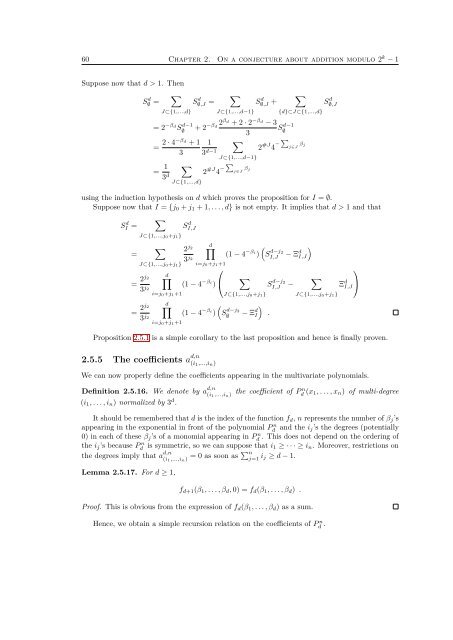here - Sites personnels de TELECOM ParisTech - Télécom ParisTech
here - Sites personnels de TELECOM ParisTech - Télécom ParisTech
here - Sites personnels de TELECOM ParisTech - Télécom ParisTech
You also want an ePaper? Increase the reach of your titles
YUMPU automatically turns print PDFs into web optimized ePapers that Google loves.
60 Chapter 2. On a conjecture about addition modulo 2 k − 1Suppose now that d > 1. ThenS d ∅ =∑J⊂{1,...,d}S d ∅,J =∑J⊂{1,...,d−1}S d ∅,J +∑{d}⊂J⊂{1,...,d}= 2 −β dS d−1∅+ 2 −β 2β d+ 2 · 2 −β d− 3dS d−13∅= 2 · 4−β d+ 1 1 ∑ ∑3 3 d−1 2 #J 4 − j∈J βj= 1 3 d ∑J⊂{1,...,d}J⊂{1,...,d−1}2 #J 4 − ∑ j∈J βjusing the induction hypothesis on d which proves the proposition for I = ∅.Suppose now that I = {j 0 + j 1 + 1, . . . , d} is not empty. It implies that d > 1 and thatS d I ==∑J⊂{1,...,j 0+j 1}∑J⊂{1,...,j 0+j 1}= 2j23 j2 d∏i=j 0+j 1+1= 2j23 j2 d∏i=j 0+j 1+1S d I,J2d∏j23 j2i=j 0+j 1+1⎛(1 − 4 −βi ) ⎝((1 − 4 −βi ) S d−j2((1 − 4 −βi ) S d−j2∑J⊂{1,...,j 0+j 1}∅− Ξ d I)I,JS d−j2I,J.− Ξ d I,J−)∑S d ∅,JJ⊂{1,...,j 0+j 1}Proposition 2.5.1 is a simple corollary to the last proposition and hence is finally proven.2.5.5 The coefficients a d,n(i 1 ,...,i n)We can now properly <strong>de</strong>fine the coefficients appearing in the multivariate polynomials.Definition 2.5.16. We <strong>de</strong>note by a d,n(i 1,...,i n) the coefficient of P n d (x 1, . . . , x n ) of multi-<strong>de</strong>gree(i 1 , . . . , i n ) normalized by 3 d .It should be remembered that d is the in<strong>de</strong>x of the function f d , n represents the number of β j ’sappearing in the exponential in front of the polynomial Pdn and the i j’s the <strong>de</strong>grees (potentially0) in each of these β j ’s of a monomial appearing in Pd n . This does not <strong>de</strong>pend on the or<strong>de</strong>ring ofthe i j ’s because Pdn is symmetric, so we can suppose that i 1 ≥ · · · ≥ i n . Moreover, restrictions onthe <strong>de</strong>grees imply that a d,n(i = 0 as soon as ∑ n1,...,i n) j=1 i j ≥ d − 1.Lemma 2.5.17. For d ≥ 1,f d+1 (β 1 , . . . , β d , 0) = f d (β 1 , . . . , β d ) .Proof. This is obvious from the expression of f d (β 1 , . . . , β d ) as a sum.Hence, we obtain a simple recursion relation on the coefficients of P n d .Ξ d I,J⎞⎠
















